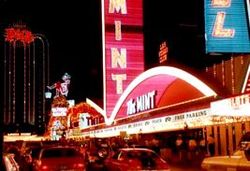

Zick & Sharp, officially Walter Zick & Howard Sharp, was an American architectural firm from Las Vegas, Nevada, in business from 1949 to 1980. The partners were Walter Zick and Harris Sharp.


Zick & Sharp, officially Walter Zick & Howard Sharp, was an American architectural firm from Las Vegas, Nevada, in business from 1949 to 1980. The partners were Walter Zick and Harris Sharp.
Walter Frederick Zick was born in New York City on May 2, 1905. He was educated at the University of Southern California, obtaining a Bachelor of Architecture in 1928 and a Master of Education in 1932. [1] By the late 1930s he had established an architect's office in Alhambra, California. [2] In 1945 he joined the office of Richard Stadelman & Associates, of Las Vegas. Stadelman's firm, dealing with the Flamingo project, required a larger office staff, and Zick was hired originally for the year alone. However, he grew to love the valley, and remained for the remainder of his career. He left Stadelman in 1948, establishing a partnership with Harris Sharp in November 1949. [1] Walter Zick was a partner in Zick & Sharp until his retirement in 1980. He died in 1990.
Harris Perry Sharp was born in El Paso, Texas on September 2, 1919. He was educated at the University of Arizona (1937–1938), University of New Mexico (1938–1940), and the University of Southern California, where he received a Bachelor of Architecture in 1943. He worked for L. L. Jone, Kenneth Wayne, and the W. C. Kruger Company. In 1947 he became a partner in the office of Las Vegas architect A. Lacey Worswick, who was formerly the city's leading practitioner. Sharp left Worswick's office in 1949 to partner with Walter Zick. [1] Zick & Sharp remained in business until Zick's retirement in 1980. The office was succeeded by Harris Sharp & Associates.